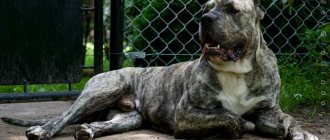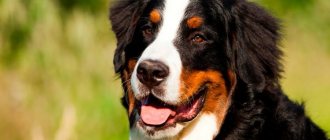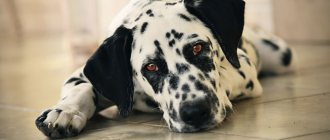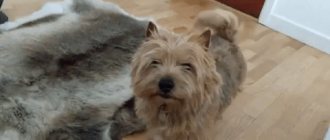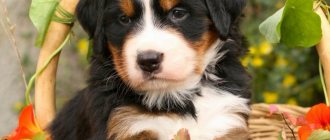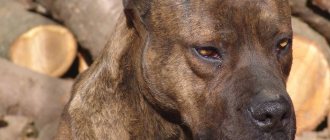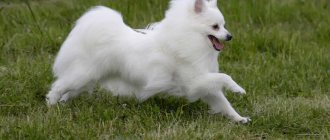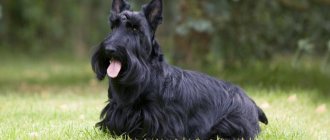Brief characteristics of the dog
- Other possible names: fila brasileiro, Brazilian Molosser, Cao de Fila.
- Adult height: females 60-70 cm, males 65-75 cm.
- Weight: females from 40 kg, males from 50 kg.
- Characteristic color: all solid or brindle colors, except white and mouse gray, without spots or specks.
- Coat length: short smooth.
- Life expectancy: 12-15 years.
- Advantages of the breed: intelligent, loyal, submissive.
- Difficulties of the breed: sharply aggressive towards strangers, independent.
- Average price: $500-$1500. The cost of an elite puppy can be $3000 or more.
Appearance
The Brazilian Terrier is a slender, medium-sized dog, well-balanced, square in build, with a strong but not heavy structure. Height at the withers of males - 35-40 cm; females - 33-38 cm. Weight about 10 kg.
The head is triangular in shape, tapering noticeably from the eyes to the nose. The skull is rounded. The groove between the eyes is well developed. The stop is noticeable. The muzzle is shaped like an isosceles triangle. The nose is moderately developed with wide nostrils. The color depends on the coat. Lips are dry and tight. Complete set of teeth, scissor bite. The eyes are located midway between the occipital protuberance and the nose, set straight, round, well open, and as dark in color as possible. Already set high, tips directed towards the outer corner of the eyes.
The neck is of moderate length, well defined, dry, clean, slightly arched. The body is square and the curves are well defined. The topline is straight and firm. The withers are well defined. The back is relatively short. The loin is strong and short. The croup is slightly sloping. The chest is deep, long, reaching to the elbows. The ribs are well sprung and the underline is moderately tucked. The tail is long or short (congenital bobtail).
The limbs are thin, dry, straight and parallel.
The coat is short, smooth, and lies close to the skin. Thinner and sparse on the head, ears, neck, and the inside of the front and hind legs. The main color is white with spots of black, blue, brown or isabella. Tan markings above the eyes, on the inner edges of the ears and on the muzzle. There may be spots on light areas of the body.
History of the origin of the breed
The history of the breed begins in the 15th century and is closely intertwined with the discovery of Brazil . When the conquistadors arrived on the shores of South America, they brought with them several working breed dogs. These were mastiffs, bloodhounds and bulldogs.
Dogs were needed to protect colonists' settlements, accompany military detachments, drive livestock and hunt jaguar and puma. In addition, with the colonization of Brazil, slavery began to develop, and dogs were needed to monitor slaves and capture fugitives. There were not enough imported and local dogs to perform these tasks. In addition, more resilient, hardworking and strong dogs were required.
Over time, native Indian dogs and native dogs of the Azores interbred with introduced dogs . Some experts claim that the blood of the Fila contains the genes of the Gonka dog, which even then was a cross between a mastiff and a bulldog.
The initial formation of the breed took place without direct human intervention. Later on farms they began to select the dogs most suitable for working qualities and cross them with each other (linear crossing). At that time, little attention was paid to the exterior. Over time, stud books began to be kept on each individual hacienda. And the dogs began to be called fila, which translated from Portuguese means to detain and escort .
The first written mention of the Brazilian Fila breed appeared in 1679 in the book of Rafael de Jesus. And the official history of dogs began in 1938 in Rio de Janeiro at the first Congress of breeders and connoisseurs of this breed, which is also called the Brazilian mastiff. At that time, there were two varieties of phyla: tall with an underdeveloped chest and shorter, but broad-chested. It was decided to breed an average dog while maintaining all its working qualities and basic characteristics . And already at this stage, Brazilian dog handlers got down to business.
After many years of selection, it was possible to obtain a single stable species , the standard of which was described in 1946 by Dr. Paulo Santos Cruz. In the same year, a unified stud book is created, into which data on phyla from all haciendas is transferred. And the doctor himself later became the founder of the first and most famous nursery “Parnapuan”.
In 1960, the breed was recognized by the international canine organization FCI under number 225. These dogs are considered the national pride of Brazil. But due to the low threshold of aggressiveness assigned to the breed, Fila is prohibited in a number of countries for keeping without special permission.
Purpose of the breed
The main purpose of dogs before the abolition of slavery was to escort and detain slaves . In this the Phils had no equal. They quickly picked up the trail and brought the fugitive back unharmed. In addition, dogs guarded plantations and master's houses , and also served in military units.
In many countries around the world, Brasileiros are used as ideal bodyguards and security guards , as well as in search teams. The breed's secondary purpose is to hunt large game , but these abilities are poorly developed in the dog.
Those who manage to find a common language with Phil acquire in him a reliable and faithful companion.
Description of the nature of the breed
The Fila Brasil is considered one of the most aggressive dogs . This is the only breed that judges are prohibited from approaching at shows. But dogs can be disqualified for excessive aggressiveness.
Phils treat any outsiders extremely unkindly . Before going on the offensive, the dog will warn you with a growl or a light touch. If this does not work, then a lightning-fast attack on the victim will not take long. Brazilians do not tolerate outside touches . Therefore, guests must be warned in advance that they should not approach the dog, especially in the absence of the owner.
Unbridled aggression is shown exclusively towards strangers . Such behavior towards one's family is taboo for the Phil. are very affectionate and flexible at any age . They incredibly combine rage with kindness and tenderness . They are caring and patient with the children with whom they live in the same house .
They may perceive others as strangers, although with less hostility than towards adults. This dog is suitable only for confident and balanced people with a stable psyche.
Character and temperament
It is believed that Fila is one of the few dogs with such strong aggression. And for good reason, in some countries this breed is prohibited. The fact is that these animals have a very strong guard instinct. They will protect their loved ones and their territory at any cost. You can't just walk up and pet this dog. He behaves with strangers no worse than a wolf. However, it is worth noting that these dogs are very family-oriented. In terms of their behavior in the house, they can resemble a cat that will follow you and pet you. They are very attached to their family, get along with children and are able to tolerate all children's fun. However, under no circumstances should other people's children be allowed near the fillet. It is very dangerous. They are extremely vicious dogs to outsiders. And they are very affectionate, gentle and sensitive to loved ones. These are very devoted and faithful friends who always feel what you need at the moment.
Choosing a puppy
Before you decide to buy a Brazilian Fila puppy, you must first find out everything about its parents and ask the owners about the character and behavior of the dogs. Naturally, such a pet must only be purebred , otherwise no one can guarantee you that problems with the dog’s behavior and psyche will not arise in the future. But the first thing that needs to be done is to carefully study all the subtleties concerning this breed and only after that decide on the appropriateness of the choice.
When choosing the puppy itself, there are several points to pay attention to:
- Properly completed documents . All purebred dogs have a mark in the groin area, the data of which must match the entry in the puppy card. It should not contain any disqualifying marks. The veterinary passport must indicate all necessary vaccinations.
- The puppy must be at least 1.5 months old and must not be malnourished or overfed.
- The head should be proportional to the body and, when viewed from above, resemble a pear. The bridge of the nose is elongated, with the upper lips hanging in an inverted “U” shape. Wide nose and large nostrils. The eyes are set wide apart and the ears are located at eye level, drooping and tapering downwards.
- Even in small puppies, the power of the entire body is already visible . The wide chest should especially stand out and the chest bone should be clearly visible.
- Straight forelimbs are widely spaced , without everting the elbow joints. The fingers should fit snugly against each other.
- The angles of the hock joints of the hind legs are a wide angle, and in no case straight.
- The neck is strong and muscular.
- The tail tapers towards the end and reaches the hocks.
You should not take an uncertain and frightened puppy . He should already be trying to growl and bark at you. If you do not like a single puppy from the entire litter, then it is better to refuse to buy from this place and continue to search for a suitable pet with whom you will live for many years.
Description of the external features of Fila Brasileiro
- The head
is perhaps the most defining characteristic of the breed. Although the dog is heavy and massive, the head should always remain proportional to the size of the dog's body. When viewed from above, it looks pear-shaped. - The muzzle
of the fila brasileiro is significantly longer than that of other mastiff type dogs and should be the same length as the skull or slightly shorter. It is strong, broad and deep (always in harmony with the skull), full under the eyes, tapering slightly towards the middle and widening until it reaches the frontal curve. From a side view, the bridge of the nose is straight or with a slight hump. The bridge of the nose is closely perpendicular to the top line. The upper lips are voluminous and pendular, forming a perfect curve, falling above the lower ones. The labial margin is shaped like an inverted and deep U. - The nose
is large, black with well-developed nostrils. - eyes
range from medium to large in size, almond-shaped, and colored to match the dog's coat color. The general expression of the eyes is one of the distinguishing characteristics of the breed. When dogs are at rest, they should look calm, noble, confident, but not boring. When alert, they show determination, firmness and cruelty. - The ears
are hanging, large, thick, v-shaped, wide at the base, tapering strongly towards the end. They should be close to the sides of the head or slightly tilted back. - The neck
of the Brazilian Mastiff is powerful with dewlap. - The body
is noticeably longer from the base of the neck to the croup than its height parameters, by about 10%. This breed is very powerful and extremely muscular. - The tail
of the Fila Brasileiro is long, usually with a low curve. It is very thick at the base but tapers sharply towards the end. - Limbs
with large bones and powerful muscles. - The paws
are large, with dense pads. - The coat
is short, smooth, thick and close-fitting. - The
Fila Brasileiro is allowed to be any solid color except white and mouse. These colors may or may not be very saturated. Spotted, black or tan dogs are not allowed. Black masks are acceptable for any color. White markings are only allowed on the paws, chest and tip of the tail.
Dog names
If the purchase of the puppy was not planned in advance, that is, you did not agree on the upcoming litter, then most likely you will be given documents along with the puppy, where his name will already be indicated. Otherwise, you will have the opportunity to choose your own name for your future pet. It is better if it is a name that emphasizes the dog's power and intelligence .
Try not to give nicknames that sound like teams or human names. In this case, the dog will get confused and take a long time to get used to its nickname, or respond to the call of passers-by.
Examples of nicknames suitable for Phil:
- for males - Bronko, Klim, Dovlad, Bishka, Boston, Zorli;
- for bitches – Ressi, Di-di, Pilet, Agen, Marley, Alania.
Care and maintenance
Phil can be kept both in a house and in an apartment . For your home, you will need a durable enclosure with a comfortable booth . But you can’t keep your dog in it all the time. Firstly, this may make her unbalanced and more aggressive. Secondly, Brazilians need space, freedom and close contact with people.
When keeping in an apartment, remember that the dog must be walked twice a day, always wearing a muzzle and away from people, and especially from playgrounds and institutions.
Phil needs to be provided with regular exercise . The ideal solution for this would be specially equipped sites.
Caring for your dog is as simple as possible . You need to clean your ears and eyes regularly. To clean the fur, just use a damp towel. After a walk in wet weather, wash your paws and thoroughly clean the dirt between the pads. This applies to dogs living in the same room as their owners.
Fila is bathed no more than twice a year . By the way, they love to swim in natural bodies of water. Regular treatment for fleas and worms is required.
Hovawart care
In general, the Hovawart is suitable for keeping in an apartment, but it needs a lot of space to move. Here, at least, the dog’s protective instinct can be realized, because there is a specific owner’s territory that can be walked around. In such conditions, the Hovawart will need to be walked for many hours every day, so that walks will literally bring him to exhaustion. Of course, it is difficult for the average owner to fulfill this requirement.
In this regard, an enclosure will also not satisfy the dog’s needs, even if you walk it for at least 2 hours in the open air. The Hovawart is absolutely not suitable for keeping on a chain. Here, not only physical activity will suffer, but also the animal’s psyche.
The dog is ideal for a private yard, where it will fully demonstrate its breed's protective qualities, having room for free movement and constant walking around the entrusted territory. But the owner must provide this territory with a high fence: the Hovawart jumps well and quickly attacks the intruder without waiting for the owner’s command.
A private yard with a high fence is an ideal place to keep a Hovawart.
Wool
At first glance at the long wavy coat of the Hovawart, it seems that it is precisely this that requires constant care. But that's not true. The dog's fur has water-repellent properties and practically does not get dirty. Therefore, Hovawarts are bathed 3-4 times a year, or as they become dirty, if the fur begins to give off an unpleasant odor.
But you need to comb your pet 1-2 times a week to prevent the formation of tangles. During the molting period, this procedure is performed daily.
Claws, ears and teeth
Unlike fur, claws, ears and teeth require more attention from the Hovawart owner.
The dog’s teeth are brushed, like other breeds, once every 7–10 days. To do this, use a special brush and paste.
A working dog does not need to trim its nails; they wear down naturally. They are only regularly inspected for chips and cracks. For domestic (and even more so for exhibition) specimens, the procedure is carried out once every 2 weeks. It is better to accustom the Hovawart to trimming its claws from puppyhood, then the procedure will be accepted by the pet calmly.
Once every 2 weeks, the pet’s ears are also cleaned. They are also checked for parasites. Thus, an unpleasant odor or discharge should prompt you to consult a veterinarian.
Nutrition
The young Hovawart dog is growing at a rapid pace. In addition, dogs of this breed are generally very active, therefore, nutrition should provide them with building material for muscles and bones, and the necessary energy.
Breeders recommend feeding Hovawarts with dry food. It should be at least premium class, ideally super premium or holistic. Such nutrition will provide all the body's needs; additional vitamin and mineral supplements are not required.
Hovawarts do not have a breed tendency to allergies or digestive disorders, so the owner can choose food depending on the pet’s own capabilities and preferences. But dogs of this breed are food lovers, so the owner should strictly follow the recommendations of the food manufacturers.
The following are suitable for feeding the Hovawart:
- Acana;
- Almo Nature Holistic Adult Dog Large;
- Barking Heads;
- Orijen;
- Pronature Original.
With natural nutrition, the owner will have to balance the diet himself and add vitamin and mineral components to it. Here it is better to consult a veterinarian.
In general, feeding Hovawarts does not differ from the diet of dogs of other large breeds:
- The basis of the menu should be lean meat (2/3 of the diet), the rest (1/3) should be plant foods.
- The meat must first be frozen. The fish is cleaned of bones.
- Fruits and vegetables are finely chopped, after removing tops and seeds. They can be given raw or cooked (stewed).
Not suitable for feeding:
- cabbage, potatoes, legumes;
- fatty meat or fish;
- sweets, confectionery, chocolate;
- food with added salt and spices, spicy and smoked.
Like other dogs, the Hovawart needs clean, free access to water. Breeders even recommend taking water with you on walks so that an active dog can satisfy its thirst.
Possible health problems
Brazilian Fila have strong immunity . But they also need vaccinations against infectious diseases. Possible diseases include:
- cardiac ischemia;
- dysplasia of the elbow and hip joints;
- eye diseases;
- ear otitis
If you eat improperly, you may experience indigestion, bloating, and volvulus . For the same reason, you should not allow your dog to run or jump immediately after feeding.
Nutrition for puppy and adult dog
When you adopt a puppy, immediately ask the breeder what they feed the dogs and follow these recommendations in the future. A sudden change in diet will not have the best effect on the digestive system. If you decide to switch your puppy or adult dog to a different food, do it gradually over several days.
The best solution for feeding Fila Brasileiro is industrial, ready-made super-premium food . It ideally combines all the elements necessary for a dog’s body, including vitamins and minerals. If the type of food is not suitable for the dog, it develops loose stools and refuses to eat.
Small puppies up to three months old are fed five to six times a day. Then up to six months - three to four times, up to a year - two to three times a day. After a year, a dog is fed in the morning and evening, exclusively after a walk.
Sometimes in the hot season, animals refuse to eat, and a single meal will be enough for them in cooler times of the day.
After each feeding, you need to remove the bowl, even if there is food left in it . And next time give a little less. This way your pet will avoid overeating. Remember that water should always be freely available . Bowls with water and food should be placed on a height-adjustable stand, at chest level.
How and what to feed?
In order for a dog to grow healthy and develop properly, it needs to be provided with proper, balanced nutrition, including the required amount of proteins, fats, carbohydrates, vitamins and minerals.
The diet of Spanish mastiffs can be based on both natural products and industrial feeds, the main thing is not to mix both types of food, as this can lead to problems with the gastrointestinal tract and cause an excess or deficiency of minerals.
Each type of nutrition has its own advantages and disadvantages.
Thus, a natural diet is varied and eliminates the possibility that the dog will get bored with food. In addition, all products included in the dog’s menu will be fresh and of high quality, since their choice is the responsibility of the mastiff owner.
Also, with a natural diet, all nutrients and minerals are better absorbed, and if an allergic reaction occurs, there is no need to completely change the dog’s diet; it is enough to eliminate the product that provoked it.
But such nutrition has significant disadvantages - it requires certain knowledge about preparing a diet and quite a lot of time preparing food for the dog.
Industrial feeds have a balanced composition and are enriched with essential vitamins and minerals. In addition, manufacturers have developed special lines of food that take into account the age, health status and activity level of dogs.
The finished product is easy to use and dose, it has a long shelf life and saves time on food preparation.
When choosing food for Spanish mastiffs, you should give preference to premium or super premium products. The most popular food brands are Brit Premium, Brit Care, Flatazor, Acana, Royal Canin.
Training and education
Fil training should be done by a strong-willed and patient person with experience in raising similar breeds . And the main goal of training dogs with such a character as this breed is complete and unquestioning obedience .
These dogs are characterized by high intelligence and intelligence . But it will be better if the training takes place under the guidance of a specially trained dog handler.
In teaching Brasileiro, rudeness and physical force are unacceptable . It may seem incredible, but these dogs are very vulnerable and touchy.
Advantages and disadvantages
The Fila Brasileiro is a dog with a complex character and a high degree of aggression . But all hostility and cruelty are directed only towards strangers, who are under no circumstances recommended to approach the dog. Fila dogs show incredible affection and tenderness towards their family . When treated correctly and properly raised, Brazilians show obedience and devotion. The dogs are balanced, calm and good-natured .
But at work, they have no equal in their ability to independently and quickly make the right decision and rush to protect their owners from ill-wishers. Fila considers all strangers to be them, without exception. The dogs are completely unpretentious in keeping and are suitable for apartments and houses.
Owner reviews
Novel:
Gorgeous dog. If I had not been the owner of a Fila, I would hardly have believed that she could be so meek and affectionate. And when she sees strangers, she really instantly becomes aggressive. To avoid any unpleasant moments, you need to study and communicate with Fila all the time.
Yuri:
This breed is not for everyone. The owner of such a dog must be a leader with knowledge of the psychology of such animals. People often get dogs for the sake of pathos, and then complain about problems with them. Philos are really not obedient, but submissive, and even to some extent meek. But this in no way concerns outsiders. Not only should they touch, but they should not be near the dog, for their own safety.
I would like to hear your opinion about the Fila Brasileiro breed. We are also waiting for your advice and recommendations on raising these dogs and behavior with them.
Share
Leave a review
Add a comment Cancel reply
- Sergey Krasnodar
I bought a two month old puppy. Very smart, quickly learned the commands Sit, Place, Come to me. Lying down is more difficult, but by 4 months I had mastered it. Very distrustful of strangers, at 3.5 months he was already guarding the yard, barking at those approaching the fence (by hearing), it’s even surprising - I had many breeds, but neither Cane Corso, nor Rottweilers, nor shepherds behaved like this. He eats Royal, but reluctantly, I add a few grains of another cheap one - then he eats it. It's almost 5 months and we're still growing. Weight about 35 kg.
Description and features
The Fila Brasileiro dog has never attacked a person to injure him. Her task was to catch the fugitive, not to harm. But, over time, they began to use it for hunting, of course, not for people.
Large dimensions and a strong body allowed the animal to defeat massive tropical game, including wild boars. But searching and hunting are not the only talents of this breed. In Brazil, it is used to protect the territory. No one will pass near Fila unnoticed. She is an example of impeccable observation.
The breed was bred using the method of multi-year selection. Dogs such as the English Mastiff, the Portuguese Guard, different types of bulldogs, etc. were crossed. As a result of these experiments, not only the brave, but also the very hardy Fila Brasileiro was born.
Some farmers use it for grazing livestock and protecting it from forest predators, wolves. The dog copes with this task excellently. Not only observation, but also absolute fearlessness helps him to be an excellent watchman.
Some people mistakenly attribute excessive anger to guard and hunting dogs. In fact, they were bred solely to help people. Even when Fila tracks down a fugitive, she does not harm him, but returns him completely unharmed. Although, her combat potential cannot but amaze. Even the most angry dogs do not show aggression towards the fillet, because they feel that they will probably lose in a fight with it.
The breed has a peculiarity - it is intolerant of the touch of strangers. The animal can lie next to its owner for hours, begging for stroking, but will never allow strangers to touch it. It may even start to growl. For this reason, the Fila Brasileiro breed is banned in many countries.
